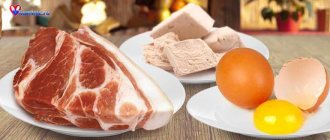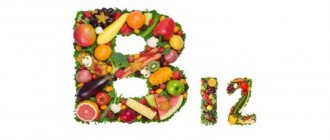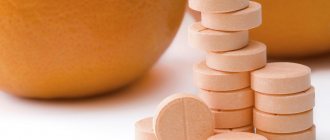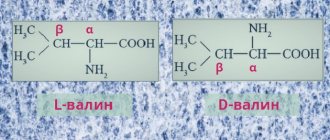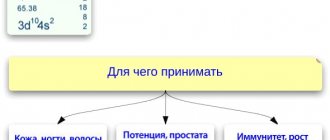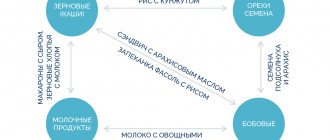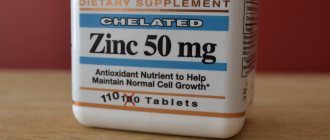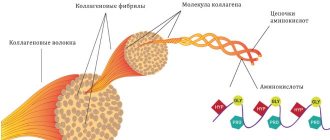Riboflavin (vitamin B2) helps maintain optimal body functions. Its importance in the transformation of amino acids, reduction and oxidation reactions is simply irreplaceable.
Most other biochemical processes occurring in our body also cannot do without riboflavin. This element dissolves extremely slightly in ethyl and water, but is quickly destroyed in sunlight.
One of the active forms can be produced in internal organs. To regulate your own health, you need to know about vitamin B2 - what foods contain it, how best to store it and how best to take it.
Daily value of vitamin B2 for women, men and children
Recommendations for the use of riboflavin have been developed in more than 30 countries. The approved dosage for adults is 1.2-2.2 mg per day. Medical observations prove that vitamin B2 deficiency forms in the body after 90 days when consuming 0.55 mg of riboflavin per day.
A healthy man should take 1.4-1.8 mg of vitamin B2, a woman - 1.2-1.3 mg. During pregnancy, the female body's need for riboflavin increases by 0.3 mg, in the first 6 months of breastfeeding - by 0.6 mg and by 0.4 mg throughout lactation. For infants in the first 6 months of life, 0.4 mg is recommended. From six months to 10 years, children are given up to 1.2 mg of vitamin B2.
| Categories of people | Daily requirement, mg |
| 0-6 months | 0,5 |
| 7-12 months | 0,8 |
| 1-3 years | 0,9 |
| 4-6 years | 1,2 |
| 7-9 years | 1,5 |
| 10-14 years | 1,6 |
| Men 15-18 years old | 1,8 |
| Men 19-59 years old | 1,5 |
| Men 60-74 years old | 1,7 |
| Men over 75 years old | 1,6 |
| Women 15-18 years old | 1,5 |
| Women 19-59 years old | 1,3 |
| Women 60-74 years old | 1,5 |
| Women over 75 years old | 1,4 |
| Pregnancy | 2,0 |
| Lactation | 2,2 |
An adult can take from 5 to 10 mg at one time. For severe symptoms of hypovitaminosis, it is allowed to take up to 10 mg three times a day. The treatment course is 1-2 months.
Factors that increase the need for vitamin B2
The need for riboflavin increases with pathologies of the thyroid gland associated with a decrease or increase in its functions. Some pharmacological drugs used in the treatment of mental disorders and tablet contraceptives cause the destruction of vitamin B2. The same property is characteristic of boric acid, the main component of most household chemicals.
Vitamin B2 is quite resistant to high temperatures, but is extremely vulnerable to light and quickly dissolves in water. It lasts a long time in foods stored in the refrigerator. During defrosting in the light, it is destroyed in vegetables and beef.
Refusal of medications and the use of boric acid will help avoid the removal of riboflavin from the body. To preserve it in frozen foods, it is recommended to immerse them in boiling water when preparing them. To defrost, it is best to wrap the meat in aluminum foil and place it in the oven.
Features of use during pregnancy
In 80% of pregnant women, a persistent drop in the level of vitamin B2 in the blood is recorded. Signs of hypovitaminosis manifest themselves in the early postpartum period with unpleasant sensations in the mammary glands, the appearance of cracked nipples, and the development of mastitis.
To avoid the appearance of negative symptoms in the last trimester of pregnancy, a woman is recommended to take 20 mg of riboflavin per day. During the first week after birth, the dosage is doubled - 20 mg twice a day.
When cracked nipples appear, local applications of 2% riboflavin ointment are added to the oral administration of the drug. It is applied to injured areas after feeding the child at least 3 times a day.
Interaction with other substances
The need for vitamins
Vitamins can be revealed differently when used in combination with other substances, physical phenomena or chemical elements:
- riboflavin is destroyed by exposure to sunlight, is almost insoluble in water and alcohol, and does not react at all to acetone, chloroform, benzene and diethyl ether. It disintegrates in the shortest possible time when it gets into an alkali and can be preserved for a long time in acids;
- the conversion of riboflavin into active coenzyme forms is enhanced by the action of thyreodine;
- chlorpromazine, used in the treatment of depression and psychosis, inhibits the conversion of riboflavin, while taking spironolactone blocks it;
- imipramine, amitriptyline, tricyclic antidepressants inhibit the metabolism of the substance;
- boric acid provokes the loss of the substance. In this case, poisoning is relieved with riboflavin.
When using various agents, their interaction with vitamin B2 .
What foods contain riboflavin, how they are prepared, how they are stored - all this is essential for maintaining the balance of the substance in the body.
Physicochemical characteristics
Needle-shaped crystals of riboflavin are yellow-orange in color, grouped into druses, and have a bitter taste. The active compound is stable in acidic environments and quickly disintegrates in alkaline environments. When heated, it retains its crystal lattice. Vitamin B2 is a natural calorifier that has a positive effect on human health. Riboflavin derivatives coenzymes are part of vital redox enzymes.
Interaction with other substances
- Vitamin K, folic acid and riboflavin enhance each other's active actions.
- Thyroidin - promotes the accelerated transition of vitamin B2 into coenzymes.
- Erythromycin, tertacycline - accelerate the excretion of riboflavin.
- Nicotinic acid in combination with B2 stimulates detoxification processes and accelerates the elimination of products formed as a result of metabolism.
- The strongest neuroleptics, antidepressants from the group of tricyclic compounds, and drugs for dilating peripheral blood vessels inhibit the utilization of riboflavin and suppress the formation of biologically active coenzyme forms.
- Vitamin B2 increases the absorption of zinc preparations.
- B2 promotes the accumulation and enhancement of the pharmacological properties of iron.
- The diuretic drug spironolactone completely inhibits the synthesis of riboflavin.
- Antihypertensive drugs and diuretics reduce the bioavailability of the vitamin and promote the rapid conversion of vitamin B2 into coenzyme compounds.
- Boric acid destroys riboflavin.
Data on the interaction of vitamin B2 and other drugs make it possible to create the most effective program for the treatment and prevention of vitamin deficiency in different groups of patients.
Vitamin B2 coenzymes
Vitamin B2 is an integral part of the coenzyme glutathione reductase, which is independently synthesized by the body. With vitamin deficiency, its activity decreases. It is necessary for the reconstruction of cellular antioxidants, such as glutathione, after the completion of the oxidation reaction. Glutathione protects cells from the negative effects of peroxide components and free radicals. With its help, the body is able to resist harmful external factors.
Glutathione, during its reaction with radicals, provides active molecules with electrons that activate compounds. Oxidation of the tripeptide occurs, accompanied by a loss of protective characteristics. The antioxidant properties of the cell are restored due to glutathione reductase, which reconstructs used glutathione and restores its activity.
Riboflavin coenzymes are an essential component of redox processes. Cell oxidation provokes the development of irreversible cellular pathologies. Containment of these mechanisms contributes to the formation of protective properties against oncological transformations.
Vitamin B2 is necessary for the metabolism of folic acid, niacin, vitamin B6 and iron. It is an essential component of coenzymes, which are necessary for the absorption of proteins, fats, and carbohydrates. Riboflavin converts nutrients into energy.
Benefit
Riboflavin is a water-soluble vitamin that cannot be found in nature. Thanks to research by scientists, the element was identified in solutions that circulate in living organisms. In its natural form, it appears as yellow crystals with a bitter taste. Riboflavin is absolutely not stable to light. Therefore, if you keep foods containing the vitamin in the light, they lose most of it. For example, if you leave a bottle of milk in a bright room for 3-4 hours, you will lose up to 70% of the vitamin B2 in its composition.
The importance of riboflavin for the body is enormous. It is involved in almost every internal process, is part of many enzymes, and is involved in metabolism. Among the most significant properties of the vitamin are those presented below.
- Participation in the production of hemoglobin.
- Removing toxins.
- Restoration of immunity and formation of red blood cells.
- Effect on the organs of vision: strengthens muscles, eliminates the risk of cataracts, allows you to see well in the dark.
- Regulation of the reproductive system.
- Activation of brain activity and strengthening of the nervous system.
- Acceleration of metabolic processes and burning of excess fat.
Thanks to vitamin B2, iron absorption is improved and the risk of anemia is prevented. This is especially important during the period of bearing a child. Riboflavin is essential for smooth skin, shiny and strong hair, strong nails and teeth. It improves the functioning of the thyroid gland, protects it from negative influences. Participates in protein, fat and carbohydrate metabolism, ensures the release of energy from incoming food.
Biological role of vitamin B2 in the human body
Without vitamin B2, physiological metabolism of fatty acids is impossible. Its level is directly related to blood glucose levels. Flavonoids of riboflavin nucleotides, converted into coenzymes, take part in protein synthesis and stimulate the formation of hemoglobin, both in normal hematopoiesis and in anemia.
The large intestine of a healthy person is inhabited by specific microorganisms that synthesize free riboflavin. The villi of the colon actively absorb it. The degree of absorption depends on the food a person prefers. In laboratory studies, it was found that more riboflavin is produced when consuming plant foods. If the daily diet is based on meat, less active compound is produced.
The extensive list of indications for the use of riboflavin is due to the spectrum of pharmacological effects:
- Antihypoxic. B2 strengthens the cell membranes of the body, helps them produce and fully use ATP molecules. With its help, oxygen metabolism in tissues is restored.
- Detoxification . Riboflavin is required for the production of glutathione, which neutralizes free radicals. Without it, the normal functioning of hepatocytes - specific liver cells - is impossible.
- Keratoplasty . Vitamin B2 preparations have an anti-inflammatory effect in skin diseases, activate regeneration processes in case of wounds and trophic ulcers.
- Anabolic. Maintaining an active sports lifestyle requires daily intake of sufficient doses of riboflavin. The drug stimulates the formation of protein in muscle fibers and accelerates plastic synthesis reactions.
- Neurotropic . The combination of B2 and lecithin ensures the formation and regeneration of the myelin sheaths of nerve fibers. Maintaining stable levels of serotonin, GABA, and dopamine is ensured with sufficient levels of riboflavin.
Vitamins of various groups, including B2, cannot be deposited in the body. To maintain optimal riboflavin levels, it is best to take vitamin supplements in pill or tablet form.
[Video] Organic chemistry, vitamin B2:
Structure of matter
The chemical formula of vitamin B2 is as follows: C17H20N4O6. It contains flavin and ribitol alcohol.
Some forms of riboflavin contain only phosphoric acid - flavin mononucleotide or FMN. There are species containing phosphoric acid associated with AMP - flavin adenine dinucleotide.
When FMN and FAD enter the human body, the vitamin is absorbed into the blood, and from there it enters all organs and systems.
Beneficial properties of vitamin B2
Riboflavin affects the production of other vitamin compounds and promotes the synthesis and development of red blood cells. Thanks to it, a high level of hormonal secretion is maintained, and metabolic reactions involving amino acids occur. B2 protects the body from peroxidation.
Application in medicine
For vitamin B2 deficiency, appropriate medications are prescribed 10 mg 3 to 5 times a day by injection or in tablet form. If, against the background of other symptoms of hypovitaminosis, ulcers appear in the corners of the mouth, local treatment is mandatory.
In addition to vitamin deficiency, riboflavin successfully copes with other unpleasant conditions:
- Headache. Supplements containing vitamin B2 significantly reduce the frequency and intensity of migraine attacks. Medical studies show that riboflavin relieves headaches. In children at a dosage of 200 to 400 mg per day, in adults - 400 mg for 3-6 months, a reduction in the frequency of attacks is observed by almost 2 times. The therapeutic effect lasts for 1.5 years [1-3].
- For eye health. A lack of riboflavin significantly increases the risk of developing glaucoma - increased intraocular pressure, which is considered one of the main causes of blindness. The use of ophthalmic drops containing B2 promotes the active prevention of cataracts, kuratoconus, glaucoma, and age-related changes [4].
- For cancer prevention. Laboratory experiments allow us to conclude that riboflavin, like other B vitamins, can prevent the development of certain oncological pathologies - rectal, colon and esophageal cancer, breast cancer, cervical cancer, prostate cancer [5].
- For the thyroid gland. Vitamin B2 regulates the hormonal activity of the thyroid gland and adrenal glands. Its deficiency significantly increases the likelihood of developing various pathologies in the thyroid tissues. The influence on hormonal levels allows one to cope with the consequences of stressful situations, regulate appetite, energy, emotional background, and body temperature [6].
- For anemia. Without riboflavin, complete synthesis of red blood cells and steroid hormones is impossible. With its help, iron is mobilized and the body cells are supplied with oxygen. B2 deficiency increases the likelihood of anemia or its sickle cell form [7].
- For Parkinson's and multiple sclerosis. Scientific studies have shown that vitamin B2 prevents the development of neurological disorders, providing a pronounced neuroprotective effect. Powerful antioxidant effect, participation in the formation of myelin sheaths, mitochondrial function - all these qualities have a beneficial effect on the body in case of neurological disorders [8].
- For Alzheimer's disease. Riboflavin is able to lower homocysteine, which the body could not independently convert into amino acids. Regular use of drugs containing B2 helps normalize homocysteine concentrations [9].
- Vitamin B2 as an antioxidant. The active compound promotes the synthesis of glutathione, an antioxidant that has a detoxifying effect and helps remove free radicals from the body.
Application in sports
Riboflavin is a constant participant in the main physiological processes occurring in the body:
- Glucose metabolism.
- Fat oxidation.
- Transport of hydrogen ions in the Krebs cycle.
All these mechanisms are carried out with the formation of energy. Athletes and sports doctors have become interested in the effect of vitamin B2 on protein synthesis. Over time, a direct relationship has been established between riboflavin doses and the quality of muscle mass. In the course of research, it was found that the female body needs high dosages of B2 for full recovery after intense exercise. Over time, it has become an integral part of sports nutrition, providing high muscle endurance.
A 20-day experiment involving 14 Canadian swimmers was indicative. The subjects were divided into two groups. One received riboflavin daily at a dose of 60 mg per day, the other received placebo. After a certain time, a swimming test was carried out - 6 times 50 meters freestyle. The results after the test showed that athletes who took vitamin B2 had improved visual acuity and the body became more resistant to hypoxia. There were no significant changes in blood or physical stability compared to the control group. [10]
The results prompted scientists to develop a special dosage for athletes. Only riboflavin coenzymes - mononucleotide, flavinate - have an anabolic effect. With their participation, the synthesis of amino acids, fats and carbohydrates occurs, oxidation and reduction reactions are normalized, and hemoglobin production is activated. These properties are the main factors of growth and restoration of physical activity.
Application in cosmetology
Riboflavin is included in cosmetics and skin care products, as it is able to preserve collagen, ensure healthy hair and skin, promote rapid regeneration, and eliminate dryness and inflammation. Collagen fibers maintain the elasticity of all layers of the skin, prevent the formation of early wrinkles, and slow down age-related changes. Chronic lack of vitamin B2 provokes earlier aging.
To prepare cosmetic masks at home, you can purchase riboflavin at the pharmacy. The drugs that contain it are available without a prescription and are affordable. Ampoule B2 should be opened immediately before use, as air provokes the destruction of the active elements. You can add riboflavin to your favorite shampoo or mask.
You can prepare an effective care product yourself, for example:
- Nourishing mask. Beat the egg yolk with a teaspoon of honey until thick white foam, add a teaspoon of castor, burdock, olive, almond or any other natural oil. All components are thoroughly mixed and an ampoule of riboflavin is added. The composition is applied to the entire length of the hair, wrapped around the head and left for 30 minutes to 2 hours. After a certain time, wash your hair as usual.
- Moisturizing mask. Good for brittle, dry, dull hair. Take a tablespoon of jojoba oil (can be replaced with avocado) and liquid glycerin, add ampoule B2. To stimulate hair growth, you can add a little rosemary, clove or mint essential oil. After applying to the hair, wrap the head with a towel. You can keep the mask as long as you have free time, it is best to leave it overnight. Wash off the composition with a small amount of shampoo.
- Firming mask. Depending on the shade of the hair, take a bag of regular or colorless henna. Pour the powder with hot water to the consistency of thick sour cream. After cooling, pour in an ampoule of riboflavin and stir. The mask is applied to the hair roots, wrapped and left for at least 2 hours. First, rinse the hair with warm water, and after 5-10 minutes wash it as usual.
Vitamin B2 content in foods
Table of percentage of vitamin B2 in food. The chart shows the percentage of vitamin B2 from the daily requirement, calculated based on a 100 g serving of the product.
| № | Quantity | Share of daily value per 100 g | |
| 1 | Dried spirulina (in powder form) | 3.7 mg | 282,3% |
| 2 | Beef liver, stewed or fried | 3.4 mg | 263,5% |
| 3 | Raw pork liver | 3.0 mg | 231,2% |
| 4 | Boiled beef kidneys | 3.0 mg | 228,5% |
| 5 | Beef kidneys raw | 2.8 mg | 218,5% |
| 6 | Beef liver raw | 2.8 mg | 211,9% |
| 7 | Stewed turkey liver | 2.7 mg | 206,7% |
| 8 | Chicken egg white powder | 2.5 mg | 194,6% |
| 9 | Dried parsley | 2.4 mg | 183,3% |
| 10 | Fried chicken liver | 2.3 mg | 177,9% |
| 11 | Turkey liver raw | 2.2 mg | 172,8% |
| 12 | Pork liver fried or stewed | 2.2 mg | 168,9% |
| 13 | Whey protein powder | 2.0 mg | 155,2% |
| 14 | Chicken liver stewed or boiled | 2.0 mg | 153,3% |
| 15 | Puffed wheat ready to eat | 1.8 mg | 138,5% |
| 16 | Puffed rice ready to eat | 1.8 mg | 138,5% |
| 17 | Chicken liver raw | 1.8 mg | 136,8% |
| 18 | Powdered egg replacers | 1.8 mg | 135,4% |
| 19 | Cooked cuttlefish | 1.7 mg | 133,0% |
| 20 | Boiled or stewed pork heart | 1.7 mg | 130,9% |
| 21 | Raw pork kidneys | 1.7 mg | 130,5% |
| 22 | Stewed pork kidneys | 1.6 mg | 122,0% |
| 23 | Cooked turkey heart | 1.5 mg | 118,5% |
| 24 | Dried coriander (cilantro) leaf | 1.5 mg | 115,4% |
| 25 | Fresh grapes (muscat varieties) | 1.5 mg | 115,4% |
| 26 | Dried mint | 1.4 mg | 109,3% |
| 27 | Cheese Brunust | 1.4 mg | 106,3% |
| 28 | Dried tarragon | 1.3 mg | 103,0% |
| 29 | Dried shiitake mushrooms | 1.3 mg | 97,7% |
| 30 | Chicken egg yolk in powder form | 1.3 mg | 96,7% |
| 31 | Paprika spice, powder form | 1.2 mg | 94,6% |
| 32 | Boiled beef heart | 1.2 mg | 93,1% |
| 33 | Hot chili peppers dried in the sun | 1.2 mg | 92,7% |
| 34 | Powdered milk | 1.2 mg | 92,7% |
| 35 | Dry basil | 1.2 mg | 92,3% |
| 36 | Milk Protein Supplement Powder | 1.2 mg | 92,3% |
| 37 | Roasted almonds | 1.2 mg | 92,1% |
| 38 | Raw pork heart | 1.2 mg | 91,2% |
| 39 | Soy flour | 1.2 mg | 89,2% |
| 40 | Fresh almonds | 1.1 mg | 87,5% |
| 41 | Turkey heart raw | 1.1 mg | 86,9% |
| 42 | Caviar, red or black, cooked (heat-treated) | 0.9 mg | 73,0% |
| 43 | Ground dry chili pepper | 0.9 mg | 72,3% |
| 44 | Raw cuttlefish | 0.9 mg | 70,0% |
| 45 | Beef heart raw | 0.9 mg | 69,7% |
| 46 | Raw goose liver | 0.9 mg | 68,6% |
| 47 | Duck liver raw | 0.9 mg | 68,6% |
| 48 | Soybeans, mature, dry | 0.9 mg | 66,9% |
| 49 | Chees Feta | 0.8 mg | 64,9% |
| 50 | Cooked bear meat | 0.8 mg | 63,1% |
| 51 | Raw quail egg | 0.8 mg | 60,8% |
| 52 | Dry muesli (with dried fruits and nuts) | 0.8 mg | 58,5% |
| 53 | Cooked chicken hearts | 0.7 mg | 57,0% |
| 54 | Caviar, red or black, raw | 0.7 mg | 56,9% |
| 55 | Antelope meat cooked | 0.7 mg | 56,2% |
| 56 | Raw chicken hearts | 0.7 mg | 56,0% |
| 57 | Energy drink Monster Energy | 0.7 mg | 54,5% |
| 58 | Raw bear meat | 0.7 mg | 52,3% |
| 59 | Dried openwork chervil | 0.7 mg | 52,3% |
| 60 | Goat cheese | 0.7 mg | 52,0% |
| 61 | Pork pancreas, cooked | 0.7 mg | 50,6% |
| 62 | Pretzels without salt | 0.6 mg | 47,9% |
| 63 | Cooked goat meat | 0.6 mg | 46,9% |
| 64 | Venison cooked | 0.6 mg | 46,2% |
| 65 | Liver pate | 0.6 mg | 46,2% |
| 66 | Raw pork shoulder | 0.6 mg | 46,2% |
| 67 | Roquefort cheese | 0.6 mg | 45,1% |
| 68 | Antelope meat raw | 0.6 mg | 44,6% |
| 69 | Unheated wheat bran | 0.6 mg | 44,4% |
| 70 | Oregano oregano, dried | 0.5 mg | 40,6% |
| 71 | Raw egg yolk | 0.5 mg | 40,6% |
| 72 | Brie cheese | 0.5 mg | 40,0% |
| 73 | Boiled chicken egg (hard-boiled) | 0.5 mg | 39,5% |
| 74 | Boiled pork tongue | 0.5 mg | 39,2% |
| 75 | Naan flatbread Indian wheat flatbread | 0.5 mg | 39,2% |
| 76 | Cheese Limburger | 0.5 mg | 38,7% |
| 77 | Fried chicken egg | 0.5 mg | 38,1% |
| 78 | Brown raw champignons | 0.5 mg | 37,7% |
| 79 | Raw goat meat | 0.5 mg | 37,7% |
| 80 | Camembert cheese | 0.5 mg | 37,5% |
| 81 | Baked salmon | 0.5 mg | 37,5% |
| 82 | Mexican Cotija cheese | 0.5 mg | 37,4% |
| 83 | Raw pork tongue | 0.5 mg | 37,3% |
| 84 | Venison raw | 0.5 mg | 36,9% |
| 85 | Fresh thyme | 0.5 mg | 36,2% |
| 86 | Turkey egg raw | 0.5 mg | 36,2% |
| 87 | Duck (duck meat) baked (meat without skin) | 0.5 mg | 36,2% |
| 88 | Irish moss raw | 0.5 mg | 35,8% |
| 89 | Roasted sesame | 0.5 mg | 35,8% |
| 90 | Raw pork belly | 0.5 mg | 35,8% |
| 91 | Fried champignons | 0.5 mg | 35,6% |
| 92 | Raw pork pancreas | 0.5 mg | 35,4% |
| 93 | Cooked squid (fried) | 0.5 mg | 35,2% |
| 94 | Raw chicken egg | 0.5 mg | 35,2% |
| 95 | Duck (duck meat) raw meat, without skin | 0.5 mg | 34,6% |
| 96 | Nutmeg spice, ground | 0.4 mg | 34,5% |
| 97 | Nori seaweed, raw | 0.4 mg | 34,3% |
| 98 | Quinoa fresh | 0.4 mg | 33,8% |
| 99 | Raw egg white | 0.4 mg | 33,8% |
| 100 | Raw pork lung | 0.4 mg | 33,1% |
| 101 | Dried rosemary | 0.4 mg | 32,9% |
| 102 | Cheddar cheese | 0.4 mg | 32,9% |
| 103 | Boiled shellfish | 0.4 mg | 32,8% |
| 104 | Dry green buckwheat | 0.4 mg | 32,7% |
| 105 | Baked trout | 0.4 mg | 32,5% |
| 106 | Reveler seeds | 0.4 mg | 32,5% |
| 107 | Bay leaf | 0.4 mg | 32,4% |
| 108 | Boiled mussels | 0.4 mg | 32,3% |
| 109 | Dried carrots | 0.4 mg | 32,1% |
| 110 | Condensed milk | 0.4 mg | 32,0% |
| 111 | Raw squid | 0.4 mg | 31,7% |
| 112 | Baked mackerel | 0.4 mg | 31,7% |
| 113 | Raw duck egg | 0.4 mg | 31,1% |
| 114 | Breadcrumbs | 0.4 mg | 31,0% |
| 115 | Fried portobello mushrooms | 0.4 mg | 31,0% |
| 116 | Raw champignons | 0.4 mg | 30,9% |
| 117 | Dried thyme | 0.4 mg | 30,7% |
| 118 | Monterey cheese | 0.4 mg | 30,0% |
| 119 | Edam cheese | 0.4 mg | 29,9% |
| 120 | Egg omelette | 0.4 mg | 29,7% |
| 121 | Raw goose egg | 0.4 mg | 29,4% |
| 122 | Blue cheeses | 0.4 mg | 29,4% |
| 123 | Raw salmon | 0.4 mg | 29,2% |
| 124 | Cumin seeds | 0.4 mg | 29,2% |
| 125 | Baked turkey thigh (fillet) | 0.4 mg | 28,8% |
| 126 | Colby cheese | 0.4 mg | 28,8% |
| 127 | Beechnut | 0.4 mg | 28,5% |
| 128 | Pecorino Romano cheese | 0.4 mg | 28,5% |
| 129 | Fenugreek seeds | 0.4 mg | 28,2% |
| 130 | Canned anchovies (in oil) | 0.4 mg | 27,9% |
| 131 | Cheese Tilsiter | 0.4 mg | 27,6% |
| 132 | Tempe | 0.4 mg | 27,5% |
| 133 | Stewed turkey gizzards | 0.4 mg | 27,5% |
| 134 | Sheep milk | 0.4 mg | 27,3% |
| 135 | Sunflower seeds, peeled | 0.4 mg | 27,3% |
| 136 | Dry baked muesli (granola), crispy, with honey | 0.4 mg | 27,2% |
| 137 | Fresh grape leaves | 0.4 mg | 27,2% |
| 138 | Fennel seeds | 0.4 mg | 27,2% |
| 139 | Mozzarella cheese | 0.4 mg | 27,2% |
| 140 | Pork neck (neck) raw | 0.4 mg | 27,2% |
| 141 | Raw oyster mushrooms | 0.3 mg | 26,8% |
| 142 | Oat bran bread | 0.3 mg | 26,6% |
| 143 | Cooked pork fillet | 0.3 mg | 26,5% |
| 144 | Spirulina raw | 0.3 mg | 26,3% |
| 145 | Veal cooked | 0.3 mg | 26,2% |
| 146 | Beef tongue raw | 0.3 mg | 26,2% |
| 147 | Pork tenderloin raw | 0.3 mg | 25,9% |
| 148 | Bread crackers | 0.3 mg | 25,9% |
| 149 | Ground sage | 0.3 mg | 25,8% |
| 150 | Rye bread | 0.3 mg | 25,8% |
| 151 | Gouda cheese | 0.3 mg | 25,7% |
| 152 | Beans, raw, mature | 0.3 mg | 25,6% |
| 153 | Parmesan cheese | 0.3 mg | 25,5% |
| 154 | Raw milkweed shoots | 0.3 mg | 25,4% |
| 155 | Trout raw | 0.3 mg | 25,4% |
| 156 | Jeera cumin seeds | 0.3 mg | 25,2% |
| 157 | Turkey gizzards raw | 0.3 mg | 25,2% |
| 158 | Pita | 0.3 mg | 25,2% |
| 159 | Dry corn grits | 0.3 mg | 24,9% |
| 160 | Baked goose | 0.3 mg | 24,8% |
| 161 | Boiled pork lung | 0.3 mg | 24,8% |
| 162 | Provolone cheese | 0.3 mg | 24,7% |
| 163 | Munster cheese | 0.3 mg | 24,6% |
| 164 | Smoked herring | 0.3 mg | 24,5% |
| 165 | Quinoa grains dry | 0.3 mg | 24,5% |
| 166 | Marjoram spice powder | 0.3 mg | 24,3% |
| 167 | Mars chocolate bar (almond) | 0.3 mg | 24,0% |
| 168 | Raw mackerel | 0.3 mg | 24,0% |
| 169 | Beaver meat cooked | 0.3 mg | 23,8% |
| 170 | Raw pork ham and rump | 0.3 mg | 23,8% |
| 171 | Malted barley flour | 0.3 mg | 23,7% |
| 172 | Pork knuckle, raw shank | 0.3 mg | 23,6% |
| 173 | Swiss cheese | 0.3 mg | 23,2% |
| 174 | Donuts | 0.3 mg | 23,2% |
| 175 | Focaccia | 0.3 mg | 23,2% |
| 176 | Raw pork spleen | 0.3 mg | 23,1% |
| 177 | Rice bran bread | 0.3 mg | 23,1% |
| 178 | Dry wheat groats | 0.3 mg | 23,1% |
| 179 | Boiled or stewed champignons | 0.3 mg | 23,1% |
| 180 | Foie gras canned | 0.3 mg | 23,0% |
| 181 | Baked herring | 0.3 mg | 23,0% |
| 182 | Milk chocolate | 0.3 mg | 22,9% |
| 183 | Fresh dill | 0.3 mg | 22,8% |
| 184 | Boiled beef tongue | 0.3 mg | 22,6% |
| 185 | Cheshire cheese | 0.3 mg | 22,5% |
| 186 | Raw ostrich meat, tenderloin | 0.3 mg | 22,4% |
| 187 | Coriander seeds | 0.3 mg | 22,3% |
| 188 | Celery seeds | 0.3 mg | 22,3% |
| 189 | Anise seeds | 0.3 mg | 22,3% |
| 190 | Millet dry millet groats | 0.3 mg | 22,3% |
| 191 | Boiled or stewed turkey neck | 0.3 mg | 22,2% |
| 192 | Wheat bran bread | 0.3 mg | 22,1% |
| 193 | Sesame flour | 0.3 mg | 22,0% |
| 194 | Cooked beef (meat without fat) | 0.3 mg | 22,0% |
| 195 | Hemp seed | 0.3 mg | 21,9% |
| 196 | Dry barley groats | 0.3 mg | 21,9% |
| 197 | Boiled soybeans (ripe) | 0.3 mg | 21,9% |
| 198 | Unheated rice bran | 0.3 mg | 21,8% |
| 199 | Dried dill | 0.3 mg | 21,8% |
| 200 | Dill seeds | 0.3 mg | 21,8% |
| 201 | Popcorn without salt | 0.3 mg | 21,8% |
| 202 | Chocolate white | 0.3 mg | 21,7% |
| 203 | Roasted turkey (meat and skin of the whole carcass) | 0.3 mg | 21,6% |
| 204 | Hot Dog | 0.3 mg | 21,5% |
| 205 | Turkey meat (turkey meat) baked (whole carcass meat) | 0.3 mg | 21,5% |
| 206 | Veal raw | 0.3 mg | 21,5% |
| 207 | Cooked lamb | 0.3 mg | 21,5% |
| 208 | Gruyère cheese | 0.3 mg | 21,5% |
| 209 | Pig brain, raw | 0.3 mg | 21,2% |
| 210 | Pork meat without fat (fillet) raw | 0.3 mg | 20,9% |
| 211 | Sponge cake layers for cake | 0.3 mg | 20,9% |
| 212 | Buckwheat dry buckwheat (brown) | 0.3 mg | 20,8% |
| 213 | Dry teff cereal | 0.3 mg | 20,8% |
| 214 | Potato chips without salt | 0.3 mg | 20,8% |
| 215 | Saffron spice | 0.3 mg | 20,5% |
| 216 | Fresh peppermint | 0.3 mg | 20,5% |
| 217 | Sunflower flour | 0.3 mg | 20,5% |
| 218 | Philadelphia cheese | 0.3 mg | 20,4% |
| 219 | Frozen edamame | 0.3 mg | 20,4% |
| 220 | Bison meat cooked | 0.3 mg | 20,3% |
| 221 | Dry wild rice | 0.3 mg | 20,2% |
| 222 | Mustard seeds ground mustard | 0.3 mg | 20,1% |
| 223 | Cheeseburger (McDonald's) | 0.3 mg | 20,0% |
| 224 | Fresh dandelion leaves | 0.3 mg | 20,0% |
| 225 | Fresh watercress | 0.3 mg | 20,0% |
| 226 | Boiled white mari | 0.3 mg | 20,0% |
| 227 | Beef brain fried | 0.3 mg | 20,0% |
| 228 | Pork spleen cooked | 0.3 mg | 19,8% |
| 229 | Pepperoni sausage | 0.3 mg | 19,8% |
| 230 | Anchovies raw | 0.3 mg | 19,7% |
| 231 | Caramel | 0.3 mg | 19,7% |
| 232 | Turkey thigh (fillet) raw | 0.3 mg | 19,6% |
| 233 | Baked pork loin | 0.3 mg | 19,5% |
| 234 | Pork ribs (country) raw | 0.3 mg | 19,5% |
| 235 | White wheat bread | 0.3 mg | 19,4% |
| 236 | Raw pork ribs (ribs) | 0.3 mg | 19,3% |
| 237 | Rye grain (rye) in dry form | 0.3 mg | 19,3% |
| 238 | Cottage cheese 2% fat | 0.3 mg | 19,3% |
| 239 | Soybean cake | 0.3 mg | 19,3% |
| 240 | Red beans (Kidney) sprouted fresh | 0.3 mg | 19,2% |
| 241 | Raw lamb | 0.3 mg | 19,2% |
| 242 | Frog legs raw | 0.3 mg | 19,2% |
| 243 | Raw pork loin | 0.2 mg | 19,1% |
| 244 | Baked sockeye salmon | 0.2 mg | 18,9% |
| 245 | Bison meat raw | 0.2 mg | 18,9% |
| 246 | Roasted sunflower seeds (hulled) | 0.2 mg | 18,9% |
| 247 | Raw goose meat | 0.2 mg | 18,8% |
| 248 | Fried chicken thighs (meat with skin) | 0.2 mg | 18,7% |
| 249 | Maitake mushrooms raw | 0.2 mg | 18,6% |
| 250 | Pork lard (with layer) raw | 0.2 mg | 18,6% |
| 251 | Cocoa powder | 0.2 mg | 18,5% |
| 252 | Raw minced chicken | 0.2 mg | 18,5% |
| 253 | Ice cream | 0.2 mg | 18,5% |
| 254 | Oat bread | 0.2 mg | 18,5% |
| 255 | Dried bananas | 0.2 mg | 18,5% |
| 256 | Cheese Port-Salut | 0.2 mg | 18,5% |
| 257 | Hamburger (McDonald's) | 0.2 mg | 18,4% |
| 258 | Cooked stewed pork | 0.2 mg | 18,3% |
| 259 | Boiled spinach | 0.2 mg | 18,2% |
| 260 | Raw pork cheek | 0.2 mg | 18,2% |
| 261 | Chicken drumstick (without skin) fried | 0.2 mg | 18,2% |
| 262 | Yogurt | 0.2 mg | 18,1% |
| 263 | Raw minced pork, 20% fat | 0.2 mg | 18,1% |
| 264 | Fried chicken legs (meat with skin) | 0.2 mg | 18,1% |
| 265 | Roasted pistachios (no salt) | 0.2 mg | 18,0% |
| 266 | Roasted salted pistachios | 0.2 mg | 18,0% |
| 267 | Herring raw | 0.2 mg | 17,9% |
| 268 | Dry mung bean | 0.2 mg | 17,9% |
| 269 | Molva baked | 0.2 mg | 17,8% |
| 270 | Raw chicken gizzards | 0.2 mg | 17,8% |
| 271 | Sweet yeast dough buns | 0.2 mg | 17,7% |
| 272 | Oatmeal cookies | 0.2 mg | 17,7% |
| 273 | Beef lung raw | 0.2 mg | 17,7% |
| 274 | Cream cheese | 0.2 mg | 17,7% |
| 275 | Raw wakame seaweed | 0.2 mg | 17,7% |
| 276 | Fried cooked pork | 0.2 mg | 17,6% |
| 277 | Pine nut without shell | 0.2 mg | 17,5% |
| 278 | Canned sardine in oil | 0.2 mg | 17,5% |
| 279 | Dry black-eyed beans | 0.2 mg | 17,4% |
| 280 | Baked pollock | 0.2 mg | 17,3% |
| 281 | Fried chicken drumstick (meat with skin) | 0.2 mg | 17,3% |
| 282 | Mexican Cheese Queso Chihuahua | 0.2 mg | 17,3% |
| 283 | Frozen spinach | 0.2 mg | 17,2% |
| 284 | Pork brain cooked | 0.2 mg | 17,2% |
| 285 | Mexican cheese Oaxaca | 0.2 mg | 17,2% |
| 286 | French green beans fresh | 0.2 mg | 17,0% |
| 287 | Unheated oat bran | 0.2 mg | 16,9% |
| 288 | Beaver meat raw | 0.2 mg | 16,9% |
| 289 | Salsify (salf's root) raw | 0.2 mg | 16,9% |
| 290 | Fresh beet tops | 0.2 mg | 16,9% |
| 291 | Cooked minced pork (20% fat) | 0.2 mg | 16,9% |
| 292 | Dry Adzuki beans | 0.2 mg | 16,9% |
| 293 | Lupine (lupine beans) dry | 0.2 mg | 16,9% |
| 294 | Cloves (spice) seasoning powder | 0.2 mg | 16,9% |
| 295 | Baked chum salmon | 0.2 mg | 16,8% |
| 296 | Dry red beans (Kidney) | 0.2 mg | 16,8% |
| 297 | Skinless chicken thighs, boiled or stewed | 0.2 mg | 16,8% |
| 298 | Dry whole wheat noodles | 0.2 mg | 16,8% |
| 299 | Shiitake mushrooms raw | 0.2 mg | 16,7% |
| 300 | Pancakes | 0.2 mg | 16,7% |
| 301 | Raw chanterelle mushrooms | 0.2 mg | 16,5% |
| 302 | Dry, ripe peas | 0.2 mg | 16,5% |
| 303 | Raw beef, meat without fat | 0.2 mg | 16,5% |
| 304 | Milk sausages | 0.2 mg | 16,5% |
| 305 | Chocolate cake layers | 0.2 mg | 16,4% |
| 306 | Baked chicken breast (skinless) | 0.2 mg | 16,4% |
| 307 | Chicken drumstick (without skin), stewed or boiled | 0.2 mg | 16,4% |
| 308 | Dry chickpeas | 0.2 mg | 16,3% |
| 309 | Dried peach | 0.2 mg | 16,3% |
| 310 | Canned horse mackerel | 0.2 mg | 16,3% |
| 311 | Dry variegated beans (Pinto) | 0.2 mg | 16,3% |
| 312 | Dry lentils | 0.2 mg | 16,2% |
| 313 | Turkey neck raw | 0.2 mg | 16,2% |
| 314 | Raw mussels | 0.2 mg | 16,2% |
| 315 | Fern (shoots) raw | 0.2 mg | 16,2% |
| 316 | KitKat chocolate bar | 0.2 mg | 16,2% |
| 317 | Sauerkraut (kimchi) | 0.2 mg | 16,2% |
| 318 | Cooked rabbit meat | 0.2 mg | 16,2% |
| 319 | Chicken gizzards, boiled or stewed | 0.2 mg | 16,2% |
| 320 | Mexican cheese Anejo | 0.2 mg | 16,1% |
| 321 | Marshmallows in chocolate | 0.2 mg | 16,0% |
| 322 | Twix chocolate bar | 0.2 mg | 16,0% |
| 323 | Raw sockeye salmon | 0.2 mg | 15,9% |
| 324 | Morel mushrooms, raw | 0.2 mg | 15,8% |
| 325 | Boiled turkey breast (fillet) | 0.2 mg | 15,8% |
| 326 | Baked turkey drumstick (without skin) | 0.2 mg | 15,8% |
| 327 | Wood mushroom raw | 0.2 mg | 15,7% |
| 328 | Cheese Fontina | 0.2 mg | 15,7% |
| 329 | Raw pork carbonate | 0.2 mg | 15,6% |
| 330 | Baked chicken drumstick (meat with skin) | 0.2 mg | 15,6% |
| 331 | Dry Lima beans | 0.2 mg | 15,5% |
| 332 | Raw pork stomach | 0.2 mg | 15,5% |
| 333 | Dry corn kernels | 0.2 mg | 15,5% |
| 334 | Enoki mushrooms raw | 0.2 mg | 15,4% |
| 335 | Durian fresh | 0.2 mg | 15,4% |
| 336 | Roasted cashews | 0.2 mg | 15,4% |
| 337 | Dry amaranth groats (seeds) | 0.2 mg | 15,4% |
| 338 | Cooked chicken feet | 0.2 mg | 15,4% |
| 339 | Beef brain raw | 0.2 mg | 15,3% |
| 340 | Soy milk | 0.2 mg | 15,3% |
| 341 | Fried chicken | 0.2 mg | 15,2% |
| 342 | Roasted peanuts | 0.2 mg | 15,2% |
| 343 | Salami | 0.2 mg | 15,1% |
| 344 | Baked pike perch | 0.2 mg | 15,0% |
| 345 | Raw chicken drumstick, meat with skin | 0.2 mg | 15,0% |
| 346 | Chocolate ice cream | 0.2 mg | 14,9% |
| 347 | Coffee with milk and sugar | 0.2 mg | 14,8% |
| 348 | Dry black beans | 0.2 mg | 14,8% |
| 349 | Cheesecake | 0.2 mg | 14,8% |
| 350 | Turkey meat (turkey meat), raw, whole carcass meat | 0.2 mg | 14,8% |
Symptoms of vitamin B2 deficiency
Hypovitaminosis can develop due to insufficient consumption of nutritious foods. Animal protein and dairy products also contribute to the development of B2 deficiency in the body. In addition to dietary factors, riboflavin deficiency can be caused by liver disease, intestinal malabsorption, frequent diarrhea, insufficient levels of thyroid hormones, and alcoholism.
A lack of vitamin B2 can lead to negative consequences:
- dermatological diseases;
- redness and swelling of the mucous membranes of the mouth and throat;
- angular stomatitis;
- swelling and cracking of lips;
- hair loss;
- problems with conception;
- sore throat;
- itchy eyes, conjunctivitis;
- liver dystrophy;
- neurological disorders.
A deficiency of riboflavin is usually combined with a deficiency of other vitamins. In severe cases of vitamin deficiency, a metabolic disorder and a decrease in the concentration of flavin coenzymes are observed. A prolonged lack of vitamin B2 threatens the development of anemia and cataracts.
Consequences
When the first signs of hypovitaminosis appear, it is quite easy to compensate for the lack of vitamin B2. Later symptoms cannot be corrected by nutritional supplements. Skin diseases, hair loss, growth retardation in children, and neurological problems require complex treatment.
Chronic riboflavin deficiency causes premature aging and negatively affects life expectancy. The cells of the body lose their ability to naturally rejuvenate.
In intrauterine development, with a deficiency of B2, untimely development of internal organs and growth retardation are detected. Children react to hypovitaminosis by slowing down all brain processes and falling behind in physical parameters. Quite often in childhood and adolescence, pathologies of the nervous system, signs of personality disorder, and underdevelopment of the meninges appear.
Externally, riboflavin deficiency can be easily identified by cracks and crusts on the lips and too pale skin color. These signs are combined with impaired pain and tactile sensitivity.
Products, content B2
You can get the right amount of the substance from several sources: from food, from vitamin complexes or dietary supplements. The following foods are considered the best sources of riboflavin:
- baker's, brewer's yeast;
- dairy products, cottage cheese;
- beef, lamb, pork;
- oatmeal and buckwheat;
- peanuts, almonds;
- cauliflower, spinach;
- legumes;
- potato;
- rye and wheat flour.
When choosing food products, it is important to consider their composition. For example, cottage cheese can be soft, grainy, wet or dry. If the cottage cheese is soft, it means the product contains a large amount of whey and vitamin B2.
When milk and other products are stored in glass containers in daylight, the vitamin is destroyed. By the way, milk loses half the amount of vitamin it contains when stored in the light for two hours.
It is recommended to cook legumes in a container with an opaque lid.
Hypervitaminosis of vitamin B2
The use of high dosages of vitamin B2, several times higher than therapeutic recommendations, does not cause symptoms of intoxication. Despite this, doctors insist that people with a history of allergies should not experiment with increasing the dosage of riboflavin.
When consuming more than 27 mg of vitamin B2, a small amount of the compound is deposited in the liver, kidneys and heart. Excess riboflavin, which is not absorbed by the body, is excreted in the urine. To determine the type of side effects, a group of subjects was offered high dosages of B2 - at least 400 mg per day for 3 months. Even with such multiple exceeding of recommendations, negative symptoms of hypervitaminosis were not recorded.
The essence and benefits of vitamin
The wealth of products containing vitamin B2
In its natural form, it can only be observed strictly in the laboratory - it is impossible to find it in its pure form in nature. But on scientists’ shelves it is stored in flasks. They look like elongated yellowish crystals and taste bitter.
To conduct experiments before chemical synthesis began, this substance was extracted from natural products - in nature it is dissolved in the liquids of animals and plants. It was then that experts found out that all organisms, in one quantity or another, contain this vitamin.
If the functions of the thyroid gland are impaired, as a result of taking medications, using boric acid and oral contraceptives, the vitamin can be destroyed. When cooking, it is very important to take into account the properties of the substance.
At first, when this substance was easily detected in every laboratory, it had many names. And only after it became clear that the substance was one and the same, it was decided to call it riboflavin.
Indications for use
Prescribing riboflavin drugs is advisable for a number of diseases:
- Hemerolopia is a pathology in which vision is impaired in the evening and at night. Vitamin B2 is prescribed together with retinol.
- Conjunctivitis of various origins is a condition in which the sclera of the eyes becomes inflamed.
- Iritis is an ophthalmological disease that occurs with inflammation of the iris.
- Inflammation of the cornea (keratitis) regardless of etiology.
- Eczema is a skin disease characterized by rashes and a burning sensation of the skin.
- Hepatitis A, other liver pathologies.
- Diseases occurring with indigestion.
- Iron deficiency anemia, in which there is a sharp drop in hemoglobin levels. The mechanism is associated with a violation of the intake, absorption and excretion of iron by the body.
- Radiation sickness is a dangerous condition that develops with prolonged exposure to radiation.
What are the symptoms of vitamin B2 deficiency?
If the body does not receive enough vitamin B2, dangerous ailments associated with metabolic disorders begin to develop, which can develop into serious diseases. The main signs of riboflavin deficiency are:
- angular stomatitis, which is cracks on the lips or in the corners of the mouth;
- inflamed tongue of bright red color;
- loss of appetite, weight loss;
- fatigue, weakness, lethargy, sudden mood swings, insomnia;
- frequent headaches, dizziness, fainting, tremors of the limbs;
- apathy, depression;
- hair loss in patches, dandruff;
- weakening of skin sensitivity, slow wound healing;
- ulceration and peeling of the skin throughout the body, especially on the lips, nasolabial folds, wings of the nose and external genitalia;
- inflammation of the mucous membranes;
- itching, dryness and feeling of sand in the eyes, increased lacrimation, conjunctivitis, night blindness and photophobia, redness of the eyeballs;
- difficulty urinating;
- weakened immunity, susceptibility to acute infectious diseases.
As can be seen from the wide range of symptoms, riboflavin deficiency is very dangerous. At the first signs of vitamin deficiency, you should start taking vitamin B2 supplements. Children especially feel the lack of microelements: they lag behind their peers in development, are physically and intellectually weak, and do not study well. With a long-term lack of vitamins, a sick person may have a thinner upper lip or even disappear altogether. Most often this symptom is observed in old people.
Vitamin B2 test
Minimal preparation is required to take a riboflavin level test. It is prohibited to eat any food 8 hours before taking biomaterial. It is allowed to drink still water. Smokers should abstain from cigarettes at least 30 minutes before the test.
Venous blood is taken for testing. On average, the level of riboflavin in the body of a healthy person is about 137-370 mcg/l.
Some pharmacological drugs affect B2 levels in the blood. Ethanol, barbiturates, thyroid hormones, tricyclic antidepressants, compounds that block tubular secretion significantly reduce riboflavin levels. Probenecid and anticholinergics can activate the absorption of B2 from the large intestine into the bloodstream.
Where can I get tested? If laboratory diagnostics are carried out in any clinic, then the blood can be tested for riboflavin levels in any case. On average, the cost of an examination is about 2,000 rubles.
How does vitamin B2 combine with other microelements?
When purchasing vitamin complexes, it is important to remember that not all substances are compatible with each other. If you take incompatible vitamins, their effect is weakened. The same can be said for riboflavin. It is not recommended to use it simultaneously with vitamin B1, since thiamine tends to be destroyed with this combination. Some time should pass between taking one and the other element. Vitamin B2 is also incompatible with vitamin C. But riboflavin goes well with zinc: it enhances the absorption of this mineral and helps it break down faster in the body. It is useful to take vitamins B2 and B6 together: this increases their effectiveness.
Names of vitamin B2 preparations in tablets
In order to purchase foreign or domestic vitamin B2 preparations at a pharmacy, a prescription is not required. Depending on the indications, you can buy tablets or an injection solution. Let us immediately note that the cost of riboflavin preparations is affordable for everyone.
The most popular riboflavin analogues include:
- Vitamin B2 - 3 mg tablets No. 30 "Teva Kutno" made in Poland.
- Riboflavin - 5 mg tablets Borisov Plant LLC, Belarus.
- DoppelHertz Active L-Carnitine + vitamin B2 - effervescent tablets.
- Solgar vitamin B2 - tablets of 50 mg in bottles of 100 pcs., made in the USA.
- Natures Bounty - tablets containing 100 mg of riboflavin, bottles of 100 pieces.
- Riboflavin mononucleotide - 1% solution for injection, ampoules of 1 ml "Pharmstandard-Ufavita", made in Russia.
Riboflavin reserves in the body
Flavins supplied with food are released in the stomach under the influence of acids and then absorbed in the upper part of the small intestine through a transport mechanism involving bile salts. In the cells of the intestinal mucosa, riboflavin is converted into the coenzyme form of flavin mononucleotide (FMN). In the transport system, it binds to plasma albumin and is carried to the liver, where it is converted into another coenzyme form, flavin adenine dinucleotide (FAD), and binds to special proteins called flavin proteins.
Riboflavin enters tissues mainly in the form of FAD, but its concentration in tissues is not high and it is not stored there in large quantities. The liver, the main storage organ, contains about a third of the body's total riboflavin content. The level of riboflavin in the blood plasma reflects the amount of riboflavin ingested from food and is normally 30-40 mcg/l. Significant concentrations of riboflavin are found in retinal tissue, but its function there is unknown. Riboflavin is excreted mainly in urine, which it gives a yellow color.
Read also Basic rules of personal hygiene and human health
A small amount of riboflavin is also excreted in sweat and bile. Riboflavin found in stool is primarily the result of intestinal bacteria. In women during breastfeeding, about 10% of absorbed riboflavin is excreted into milk.
How to preserve riboflavin in food?
Riboflavin, like any water-soluble vitamin, is absorbed quickly and is washed away just as easily. Cooking food using heat treatment leads to the fact that B2 is completely destroyed.
To maintain the maximum concentration of riboflavin in foods, it is important to follow some rules:
- Frozen foods should be placed in boiling water immediately. It is better to wrap frozen meat and fish in foil and put it in the oven to defrost. Under no circumstances should frozen fruits and vegetables be left to thaw at room temperature. In this case, riboflavin is destroyed by exposure to oxygen.
- Dairy products, meat, and fish are not left in the light. Sun rays cause rapid destruction of the vitamin and lead to rapid rotting of food.
- Pasteurized milk, which contains riboflavin, is not boiled, but consumed fresh.
- When cooking meat, fish, and vegetables, cover the pan with a lid. This is necessary for the least contact of products with oxygen.
- If you want to preserve vitamin B2 in foods, you should avoid soaking and marinating them. Aggressive vinegar and salty marinades contribute to the destruction of riboflavin.
Of course, a daily diet is impossible without thermally processed foods. Therefore, to provide the body with a sufficient amount of riboflavin, it is necessary to systematically consume dairy products and dried fruits.
- Soft cottage cheese contains more vitamin B2. This is due to the large amount of whey remaining in the product.
- If you leave milk in a glass container on the table during the day, the loss of riboflavin in 2 hours will be 50%.
- Always cover the cookware with a lid when cooking food. Most vitamins are destroyed by interaction with oxygen. Do not discard the water in which peas or potatoes were cooked, as this will leave riboflavin and other B vitamins washed out of the food.
- Washing vegetables and fruits in large amounts of water causes the loss of some of the riboflavin they contain. About 1% per day of nutrients is destroyed when stored in the refrigerator.
Food should be stored in a dark place, do not leave it in the light for a long time. It is best to eat fresh vegetables and fruits without heat treatment. Cooking in a double boiler ensures the least loss of vitamins.
What products does it contain?
Riboflavin is found in foods such as meat, milk, yeast, legumes and others. © https://ydoo.info/micro/vitamin-b2-riboflavin.htmlFood sources have a varied content of the valuable element. Foods high in B2:
- offal (kidneys, liver);
- eggs;
- meat;
- seafood;
- dairy and fermented milk products;
- legumes;
- apricot kernels;
- mushrooms;
- cereals, pasta and bakery products;
- fruits vegetables;
- greenery.
Products containing riboflavin may lose some of their beneficial properties during heat treatment, during washing, or during long-term storage in transparent containers. In order to preserve the useful properties of the element as much as possible, you should follow some rules.
For example, dairy products should not be stored in a transparent container in daylight. Soft cottage cheese is richer in B2 content due to the increased amount of whey. Long-term storage of food negatively affects its preservation, as does prolonged washing of food.
Excursion into history
Polish scientist Kazimierz Funk is the founder of vitaminology; he played a major role in the discovery of useful organic substances. It was Funk who discovered and synthesized thiamine, the first representative of the numerous B group. Vitamin B2 itself was discovered much earlier, at the end of the 19th century, in 1879, by the scientist Bliss. However, in those years it was not possible to identify a heat-resistant molecule as vitamin B2, since the very concept of “vitamins” did not exist.
Richard Kuhn
It was not until 1935 that numerous scientific studies came to fruition when the German researcher and biochemist Richard Kuhn synthesized riboflavin powder in its pure form. This event made a real revolution in vitaminology, since before the discovery of the heat-resistant molecule, thiamine was considered an independent, single substance. The discovery of vitamin B2 riboflavin confirmed the assumption of the multiple composition of group B. Since then, thiamine has been considered a precursor, the first representative of the B vitamin series; riboflavin received serial number 2.
Later, other similar organic compounds with similar properties and structure were discovered, all of which made up a series of coenzymes with indices from B 1 to B 20.
Now Foods, B-2, 100 mg, 100 capsules
from 404 ₽
More details

